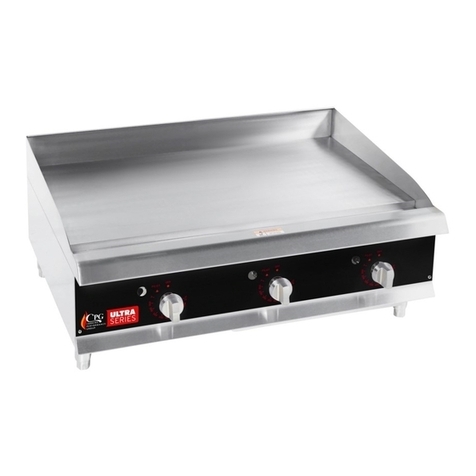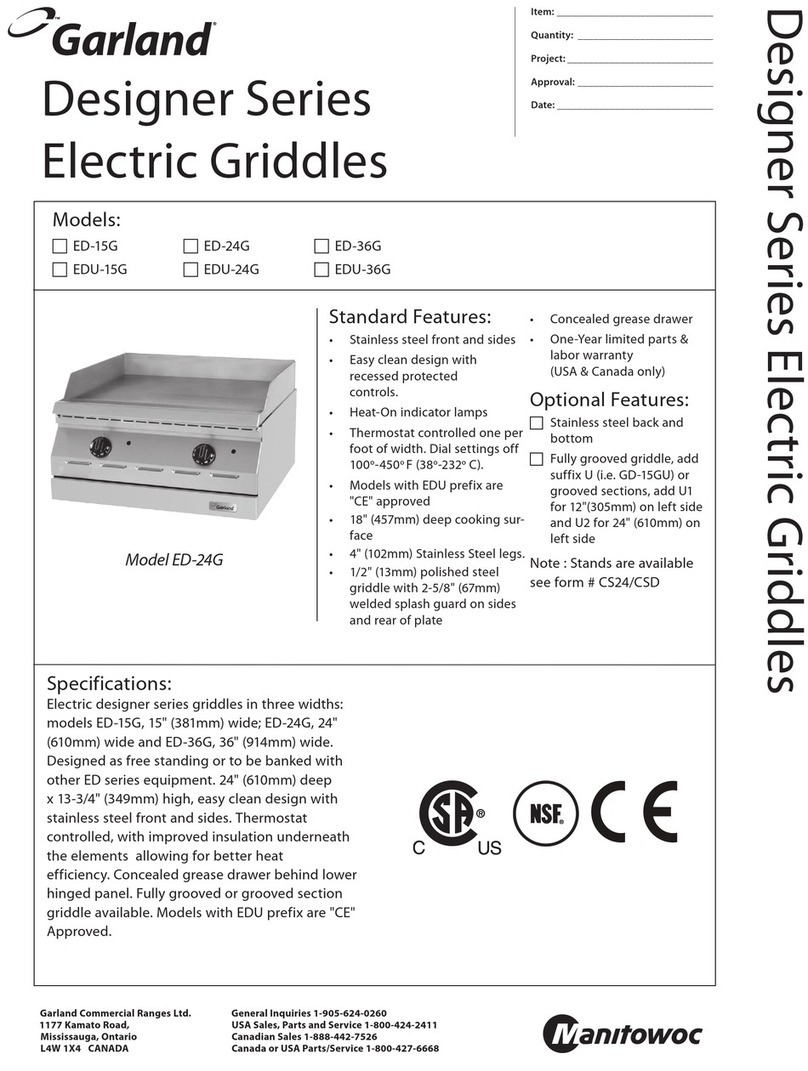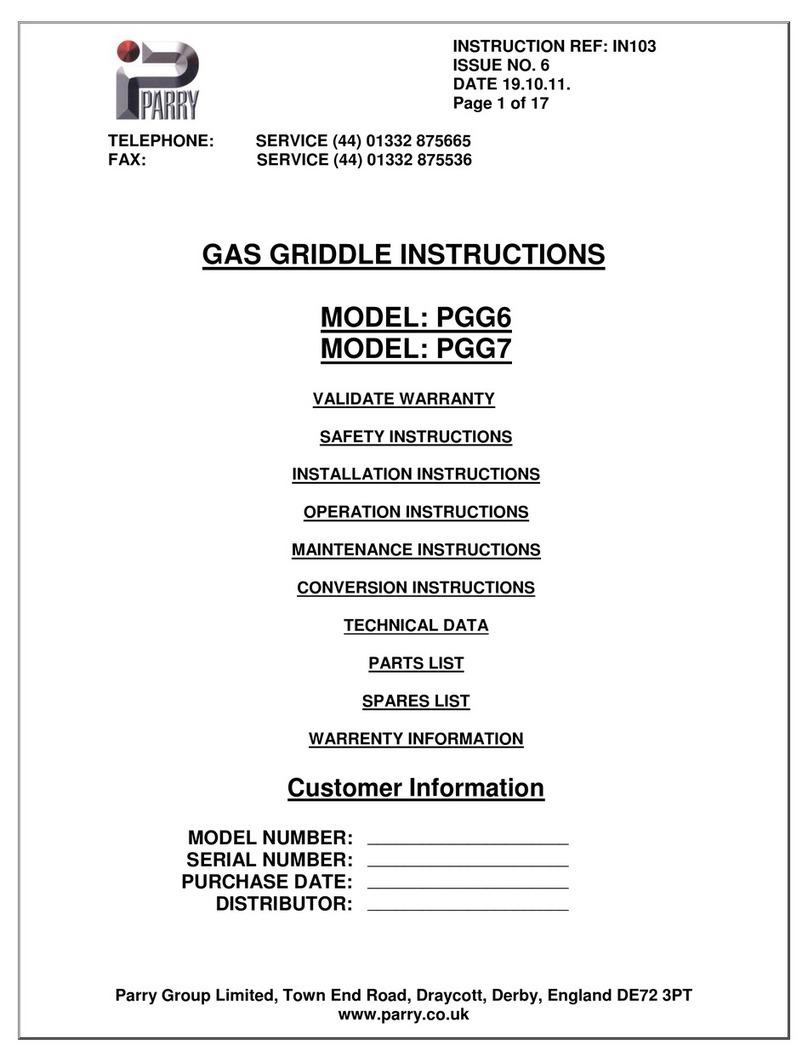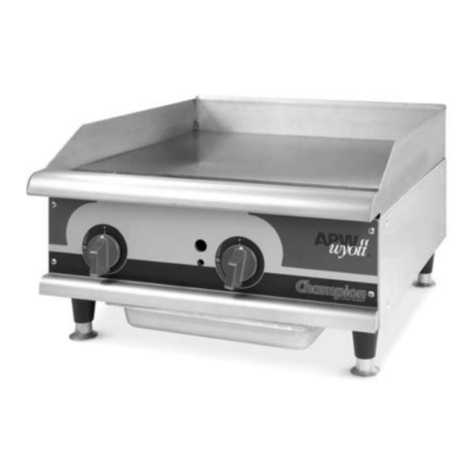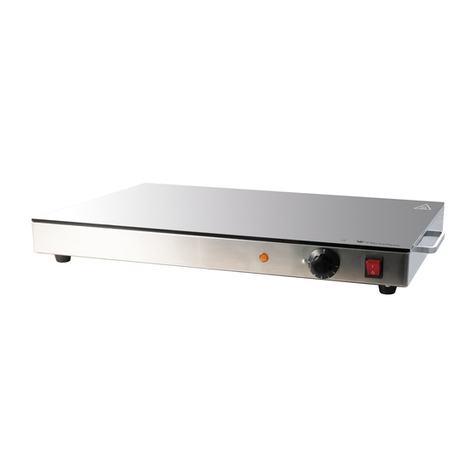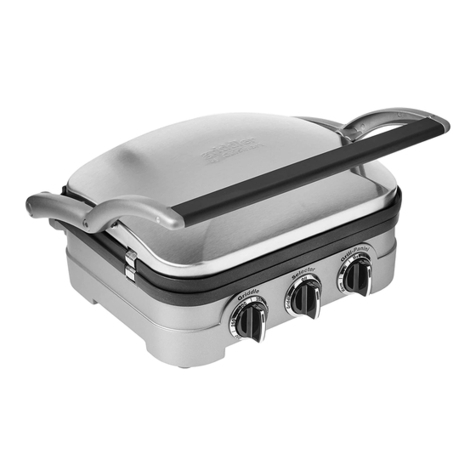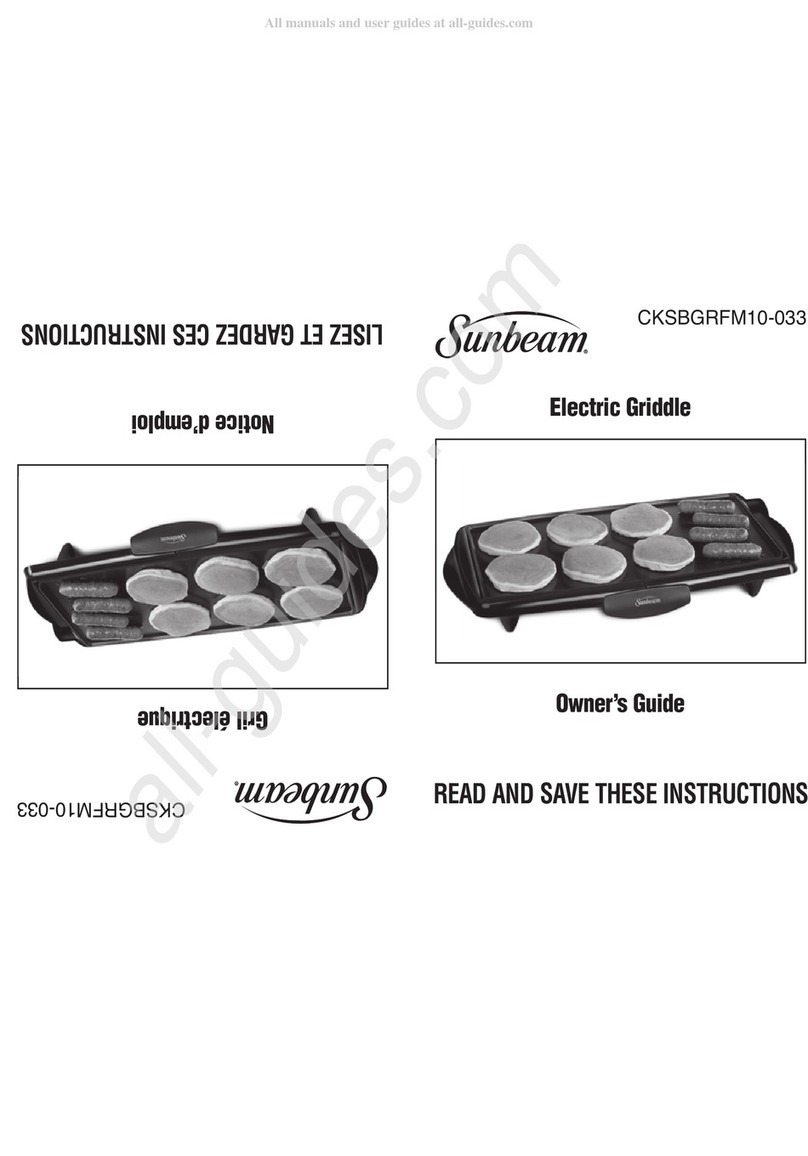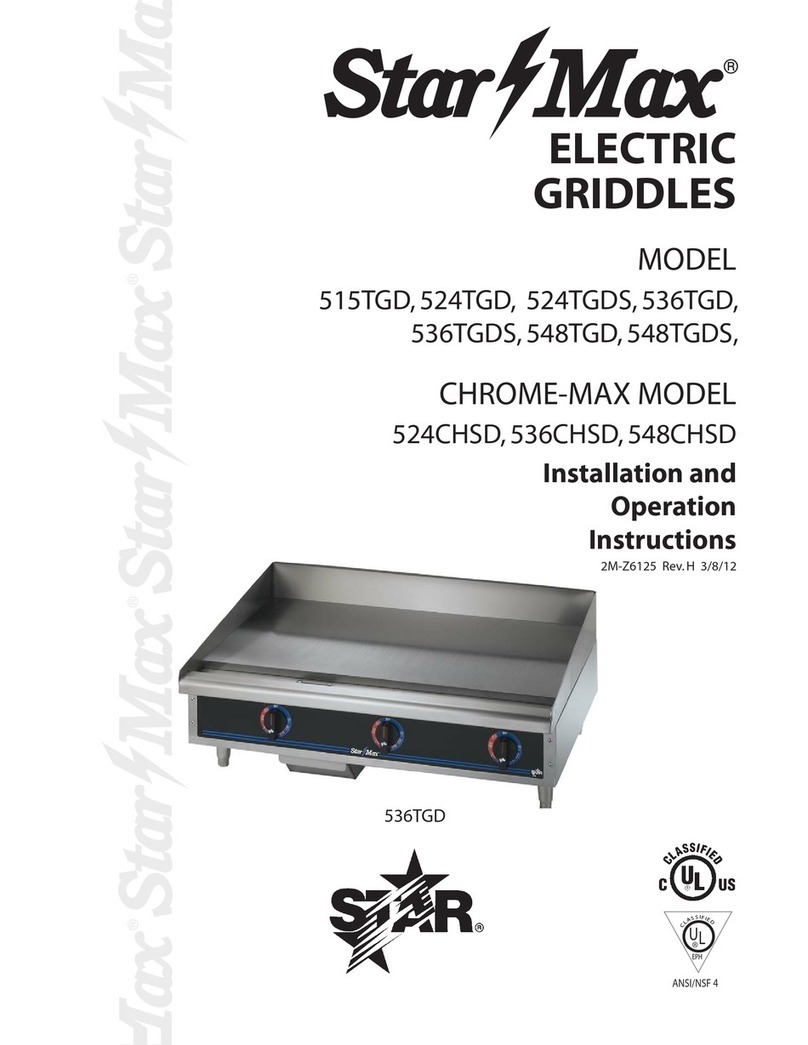Eurotec DOMINA 700 Series Quick start guide

ISTRUZIONI PER L’INSTALLAZIONE, L’USO E LA MANUTENZIONE
INSTALLATION, USE AND MAINTENANCE INSTRUCTIONS
INSTRUCTIONS POUR L’INSTALLATION, L’EMPLOI ET L’ENTRETIEN
INSTALLATIONS-, BETRIEBS-UND WARTUNGSANLEITUNGEN
INSTRUCCIONES PARA LA INSTALACIÓN, EL USO Y EL MANTENIMIENTO
10/09/2007 Rev.2 167275
FRY-TOP A GAS SERIE DOMINA 700
SECONDO NORMA: EN 437 e EN 203 parte 1 e 2 Categoria II per Gas Metano e G.P.L.
GAS HEATED GRIDDLE PLATE DOMINA 700 SERIES
ACCORDING TO: EN 437 and EN 203 part 1 and 2 Cat. II for Natural gas and L.P.G.
FRY-TOP AU GAZ SERIE DOMINA 700
CONFORME AUX NORMES: EN 437 et EN 203 1ère et 2ème partie pour Gaz Méthane et G.P.L.
GASBEHEIZTE BRAT-UND GRILLPLATTE SERIE DOMINA 700
NACH: EN 437 und EN 203 Teil 1 und 2 Kategorie II für Erdgas und Flüssiggas
FRY-TOP A GAS SERIE DOMINA 700
SEGÚN: EN 437 y EN 203 parte 1 y 2. Categoría II: Metano y G.P.L.
GFT477...
GFTA477...
GFT777...
GFTA777...
GFT1177...
GFTA1177...
I
GB
F
D
E
0 6 9 4

- 2 -
I
CAPITOLO DESCRIZIONE PAGINA
INDICE
ITALIANO ................................................................................................ pagina 2 - 9
ENGLISH ................................................................................................. page 10 - 17
FRANÇAIS ............................................................................................... page 18 - 25
DEUTSCH ................................................................................................ Seite 26 - 33
ESPAÑOL ................................................................................................ página 34 - 41
Aavvertenze generali ........................................................................................................................... 3
1. Dati tecnici .......................................................................................................................................... 4
1.1 Fry-top a gas serie DOMINA 700 CAT. II (Gas metano e G.P.L.) ........................................................ 4
1.2 Caratteristiche tecniche ....................................................................................................................... 4
2. Istruzioni per l’installazione ............................................................................................................... 4
2.1 Informazioni riguardanti i fry-top a gas serie DOMINA 700 .............................................................. 5
2.2 Legge, norme e direttive tecniche da rispettare .................................................................................. 5
2.3 Luogo d’installazione ......................................................................................................................... 5
2.4 Posizionamento ................................................................................................................................... 5
2.5 Montaggio apparecchiature top su base o supporto a sbalzo ............................................................. 5
2.6 Tabella II: Dati tecnici gas, pressione, ugelli bruciatore, pilota e vite del minimo
(Valido per tutti i bruciatori dei fry-top serie DOMINA 700) ............................................................. 6
2.7 Collegamento all’impianto del gas ..................................................................................................... 6
2.7.1 Come ottenere la portata termica nominale ........................................................................................ 6
2.7.2 Controllo della pressione .................................................................................................................... 7
2.7.3 Regolazione della portata termica minima ......................................................................................... 7
2.7.4 Controllo per il funzionamento a gas liquido .................................................................................... 7
2.7.5 Controllo del funzionamento .............................................................................................................. 7
2.8 Introduzione dell’utente ..................................................................................................................... 7
3. Trasformazione per funzionamento ad altro tipo di gas ..................................................................... 7
4. Sostituzione dei componenti piu’ importanti ..................................................................................... 8
5. Istruzioni per l’utente .......................................................................................................................... 8
5.1 Accensione bruciatore pilota .............................................................................................................. 8
5.2 Accensione bruciatore ......................................................................................................................... 8
5.3 Uso della piastra cromata .................................................................................................................... 9
6. Manutenzione e pulizia ...................................................................................................................... 9
SCHEMI DI INSTALLAZIONE ........................................................................................................... 42

- 3 - I
- Leggere attentamente le avvertenze contenute nel presente libretto in quanto forniscono importanti
indicazioni riguardanti la sicurezza di installazione, d’uso e di manutenzione.
- Conservareconcuraquestolibrettoperogniulterioreconsultazionedeivarioperatori.
- Dopo aver tolto l’imballaggio, assicurarsi dell’integrità dell’apparecchiatura e in caso di dubbio, non utilizzare
l’apparecchiaturaerivolgersiapersonaleprofessionalmentequalificato.
- Primadicollegarel’apparecchiatura,accertarsiche i dati riportati sulla targhettasianocorrispondentiaquellidella
rete di distribuzione gas.
- Questa apparecchiatura deve essere destinata solo all’uso per il quale è stata espressamente concepita, ogni
altro uso è da considerarsi improprio e quindi pericoloso.
- L’apparecchiaturadeveessere utilizzatasolodapersonaaddestrataall’uso della stessa.
- Per eventuale riparazione rivolgersi solamente ad un centro di assistenza tecnica autorizzato dal costruttore e
richiedere l’utilizzo di ricambi originali.
- Ilmancato rispetto di quanto sopra, può comprometterelasicurezzadell’apparecchiatura.
- Nonlavare l’apparecchiatura con getti d’acqua diretti e adaltapressione.
- Non ostruire le aperture o feritoie di aspirazione o di smaltimento del calore.
AVVERTENZE GENERALI
IL TIPO DI UGELLO INDICATO NELLE TABELLE È FRUTTO DI SEVERE PROVE DI LABORATORIO PER CUI UNA
SOSTITUZIONE CON ALTRO DIFFERENTE, OLTRE CHE FAR CADERE OGNI GARANZIA NON PORTA NESSUN MI-
GLIORAMENTO NELLE PRESTAZIONI O NEL MONTAGGIO.
IN CASO DI INOSSERVANZA DELLE NORME CONTENUTE NEL PRESENTE MANUALE, SIA DA PARTE DELL’UTEN-
TE CHE DA PARTE DEL TECNICO ADDETTO ALL’INSTALLAZIONE, LA DITTA DECLINA OGNI RESPONSABILITÀ
ED OGNI EVENTUALE INCIDENTE O ANOMALIA CAUSATO DALLE SUDDETTE INOSSERVANZE NON POTRÀ ESSE-
RE IMPUTATO ALLA STESSA.
LA CASA COSTRUTTRICE DECLINA OGNI RESPONSABILITÀ PER LE POSSIBILI INESATTEZZE CONTENUTE NEL
PRESENTE OPUSCOLO, IMPUTABILI AD ERRORI DI TRASCRIZIONE O STAMPA. SI RISERVA INOLTRE IL DIRITTO
DI APPORTARE AL PRODOTTO QUELLE MODIFICHE CHE SI RITENGONO UTILI O NECESSARIE, SENZA PREGIU-
DICARE LE CARATTERISTICHE ESSENZIALI.

- 4 -
I
1.1 FRY-TOPA GAS SERIE DOMINA 700 CAT. II (GAS METANO E G.P.L.)
1.2 CARATTERISTICHE TECNICHE
Struttura portante in acciaio inox AISI 304, montata su piedini regolabili in altezza e con piano di appoggio in gomma.
-PIASTRA di cottura in acciaio speciale ad alta conducibilità termica nella versione liscia e rigata, con alzatina perimetrale
paraspruzzi in acciaio inox 18/10; versione C, piano di lavoro cromato.
- CASSETTO raccoglisughi e grassi in acciaio inox AISI 304.
- RISCALDAMENTO A GAS mediante bruciatori a fiamma autostabilizzata in acciaio inox AISI 304 che garantiscono
uniformità di riscaldamento della piastra. Regolazione termostatica della temperatura con valvola di sicurezza e termocoppia
per l’interruzione dell’afflusso del gas in caso di spegnimento accidentale del bruciatore pilota. Accensione piezoelettrica
al pilota.
- COMANDI INDIPENDENTI per ogni zona piastra per temperature differenziate nei modelli GFT777 e GFT1177.
*ALTEZZA TOTALE = 425mm.
MODELLO GFT477...
GFTA477... GFT777...
GFTA777... GFT 1177...
GFTA1177...
DIMENSIONI
in mm.
TIPOSCARICO
ESTERNO
PIASTRA
ATTACCO GAS
PORTATATERMICATOTALE (Hi)
CONSUMO
GAS (15°C)
GPL G30 / G31
METANO H- G20
METANO L-G25
PESONETTO
L x P x A*
L x P
kW
g/h
m3/h
m3/h
kg.
A1
400 x 700 x 330
350 x 500
G 1/2”
5,5
433 - 427
0,582
0,677
36
A1
700 x 700 x 330
650 x 500
G 1/2”
11,0
866 - 854
1,164
1,354
70
A1
1100 x 700 x 330
1050 x 500
G 1/2”
16,5
1300 - 1282
1,746
2,031
104
1. DATI TECNICI
L’installazione e l’eventuale trasformazione per l’uso di altri tipi di gas, deve essere eseguita da persone qualificate
secondo la normativa in vigore.
Vedere tabelle dati tecnici: 1.1 e 2.6.
AVVERTENZE:
Nel caso in cui l’apparecchiatura venga installata contro una parete quest’ultima deve resistere ai valori di temperatura di
90°C e deve essere incombustibile.
Prima di procedere all’installazione, togliere dal rivestimento la pellicola di protezione in plastica, eliminando gli eventuali
residui adesivi con prodotto adatto alla pulizia per l’acciaio inossidabile.
Installare l’apparecchio in posizione orizzontale, la corretta posizione si otterrà ruotando i piedini livellatori.
Qualora l’apparecchiatura venga installata singolarmente si consiglia di fissarla per rendere più sicura la sua stabilità.
2. ISTRUZIONI PER L’INSTALLAZIONE

- 5 - I
2.2 LEGGE, NORMEEDIRETTIVETECNICHEDARISPETTARE
Per l’installazione sono da osservare le seguenti norme:
- Prescrizioni vigenti antinfortunistiche e antincendio.
- La regolamentazione dell’ente erogatore del gas, dal quale bisogna farsi rilasciare il nullaosta prima dell’installazione.
- Norme «Installazione impianti a gas».
- Norme igieniche.
2.3 LUOGOD’INSTALLAZIONE
- L’apparecchio deve essere installato in locali con sufficiente areazione. Questo apparecchio richiede una aspirazione di
almeno 2 m3/h • kW P.T. (Portata Termica).
- Installare l’apparecchiatura secondo quanto previsto dalle norme di sicurezza UNI - CIG 8723, legge N° 46 del 5-3-’90 e
D.M. N°74 del 12.04.96.
2.1 INFORMAZIONI RIGUARDANTI I FRY-TOPA GAS SERIE DOMINA 700
Questo libretto è valido per nostri Fry-Top serie DOMINA 700 del tipo A1 Categoria II (Gas naturale e Liquido G.P.L.).
Vedere tabella 1.1 e 2.6.
La targhetta secondo le norme EN437 e EN 203 parte 1 si trova all’interno dell’apparecchio e/o sul retro.
Esempio targhetta Italia: Cat. II 2H3+
Pe = Pressione a monte
Pi = Pressione all’ugello
2.4 POSIZIONAMENTO
- Le varie apparecchiature possono essere installate singolarmente o possono essere accoppiate ad altre apparecchiature della
nostra stessa gamma.
- Questa apparecchiatura non è idonea per l’incasso.
- La distanza dalla pareti laterali deve essere minimo di 10 cm., nel caso in cui la distanza fosse inferiore o il materiale delle pareti
o del pavimento fossero infiammabili, è indispensabile l’applicazione di un isolante termico.
2.5 MONTAGGIOAPPARECCHIATURE TOP SU BASE O SUPPORTOA SBALZO
Tutte le apparecchiature top sono munite di piedini
regolabili in altezza (P):
- Quando l’apparecchiatura deve essere sistemata libera
su un tavolo o un piano, avvitare o svitare i piedini (P)
come indicato in figura sino a farla appoggiare
perfettamente, quindi stringere il controdado (D) in
modo da bloccare il piedino. Per impedirle di scivolare,
infilare nei buchi inferiori dei piedini i tappi in gomma
(M).
- Quando l’apparecchiatura deve essere fissata su una
base o su un supporto a sbalzo, regolare i piedini (P)
sino a farla appoggiare perfettamente, stringere poi il
controdado (D) in modo da bloccare il piedino. Fissare
quindi da sotto mediante viti M5 (T) con relative
rondelle avvitandole ai piedini come indicato in figura.
VHz kW Type
tipo
Mod.
Matr.N°
Cat.
P n
Cat.
P n
PT
Qn
(Hi)
G20
G25
m3/h
m3/h
G30
G31
Kg/h
Kg/h
mbar
KW
mbar
II2H3B/P
20,50/50
II2L3B/P
25,30,30
NL AT-CH
II2H3B/P
20,30/30
II2H3+
PLIS-MT-CY FR - BE DE LUIT-GR-GB-ES-IE-PT
II2H3+
20,29/37
II2E+3+
20/25,29/37
II2ELL3B/P
20,20,50/50
I3B/P
30/30
II2E3P
20/37
I2E; I3+
20,29/37
20,50/67
NO-SE-EE-LT-DK-LV-CZ-SK-SI-FI-TR-HR-BG-RO

- 6 -
I
2.6 TABELLA II: DATI TECNICI GAS, PRESSIONE, UGELLI BRUCIATORE, PILOTA EVITE DEL
MINIMO (VALIDO PER TUTTI I BRUCIATORI DEI FRY-TOP SERIE DOMINA 700)
(1) Compreso portata termica pilota circa 200W K = Ugello corto 15 mm. F= fisso
R.d.A. = Regolazione dell’aria primaria
Nazione
e
Categoria
Cat.
UGELLO Tipo
di
GAS
PRESSIONEGAS
A MONTE mbar
Nom. Min. Max
BRUCIATORE
Ø mm
Tipo
MARCATO
R.d.A
X mm
ITALIAII2H3+
ITALIAII2H3+
2H
3+
G20
metano
G30
butano
G31
propano
20
29
37
17
20
25
25
35
45
175 K
115 K
20
20
BY-PASS
(22 S)
Ømm
MARCATO
PILOTA
1 VIA
“TARGHET”
MARCATO
Press. Gas
all’Ugello
con 25ST
95
65
27
19
Max
mbar Min.
mbar
Portata
Termica
nom. kW (1)
100% P.T.
Min.
ca.
Consumo
Gas
(15°C)
l/h g/h
18,9
28,7
36,6
1,4
1,9
2,1
5,5*
5,5*
1,7*
1,7*
582
171
225
-
435
429
2.7 COLLEGAMENTOALL’IMPIANTO DEL GAS
- L’apparecchio deve essere alimentato con gas avente le caratteristiche e la pressione riportata in tabella II.
- La pressione del gas si misura alla presa di pressione iniziale con il bruciatore acceso (vedere Fig. 1)
- L’apparecchiatura è collaudata e predisposta per funzionare a gas metano H G20 - 20 mbar.
* N.B. Se la pressione in rete varia più del +10% della pressione nominale, viene consigliato di montare un regolatore di
pressione a monte dell’apparecchio per garantire la pressione nominale.
- L’allacciamento alla rete del gas deve essere effettuato con tubazione metallica di adeguata sezione e deve essere inserito
a monte un rubinetto di intercettazione omologato.
- Dopo l’allacciamento alla rete del gas, controllare che non esistano perdite nei punti di raccordo con appositi strumenti o
con acqua saponata.
SCARICO DEI PRODOTTI DI COMBUSTIONE SOTTO UNA CAPPA DIASPIRAZIONE.
APPARECCHIO DEL TIPO:A1
L’apparecchiatura a gas va sistemata sotto una cappa di aspirazione il cui impianto deve avere le caratteristiche conformi alle
Norme. Questo apparecchio necessita di almeno 2 m3/h • kW P.T. (Portata Termica).
Controllare l’aerazione della cucina; deve essere secondo le norme in vigore.
2.7.1 COME OTTENERE LA PORTATA TERMICA NOMINALE
Controllare se l’apparecchio è predisposto per il tipo di gas, pressione e categoria che corrisponde con il gas disponibile in
rete. Indicazione riportata sull’imballo e/o targhetta sull’apparecchio.
Se l’apparecchio è predisposto per un altro tipo di gas e pressione, occorre prima fare una trasformazione per il funzionamento
ad altro tipo di gas.
Vedere la Tabella II per l’ugello, vite del minimo (by-pass), regolazione dell’aria primaria, (X mm), l’ugello del pilota e la
pressione all’ugello del bruciatore principale.
N.B.: I nomi degli ugelli «2H» e «3+» sono visibili nella parte sinistra della Tabella II.
2H = G 20 - 20 mbar
3 + = G 30 - 29 mbar e/o G 31 - 37 mbar una coppia di gas e pressione.
Nel nostro settore abbiamo quasi sempre a che fare con G 31 - 37 mbar!
Nella Tabella II sono riportati i tipi di gas e pressione per tutti i bruciatori e i relativi ugelli, la distanza X mm della regolazione
dell’aria primaria (vedere Fig. 3), la vite del minimo (by-pass), l’ugello del pilota, la pressione massima e minima all’ugello,
la portata termica massima e minima e il consumo gas in l/h (15°C) o in g/h in caso di G.P.L.
Attenzione: Se la pressione «dinamica» del gas a monte dell’apparecchio è inferiore alla pressione minima della Tabella II,
l’allacciamento è proibito; l’installatore deve comunicare all’azienda del gas che la pressione in rete è troppo bassa (G20 o
G25).
N.B.: Se la pressione varia più del +10% della pressione nominale p.e. per G 20 - 22 mbar viene consigliato di montare un
regolatore di pressione a monte dell’apparecchio per garantire la pressione nominale.
Se la pressione in rete è oltre la pressione massima della Tabella II p.e. per G 20 - 25 mbar avvertire l’azienda del gas.
Controllare se la pressione in entrata ed all’ugello corrisponde con i valori riportati nella Tabella II.
NOTA: *i valori vanno moltiplicati per 2 nel caso di GFT777... e moltiplicati per 3 nel caso di GFT11777... .

- 7 - I
3. TRASFORMAZIONE PER FUNZIONAMENTO AD ALTRO TIPO DI GAS
Togliere la bacinella raccogli grassi (18 fig. 6). Togliere la manopola (20 fig. 6), le viti (17 fig. 6) e il cruscotto (17 fig. 6).
Eventualmente togliere la piastra; se la piastra viene rimossa, svitare le viti che tengono fissato il bulbo quindi sfilarlo
facendo particolare attenzione. A fine operazione riposizionare il bulbo avvitando le viti nella precedente posizione.
SOSTITUZIONE UGELLO BRUCIATORE
N.B.: Per non rompere la candeletta conviene smontarla prima (9 e 10 Fig. 4).
Per cambiare l’iniettore del pilota, occorre svitare il dado (7 fig. 4) con una chiave del 10 e sostituire l’iniettore (6 fig. 4) con
quello corrispondente al tipo di gas prescelto e indicato nella tabella II.
SOSTITUZIONE UGELLO BRUCIATORE.
Sostituire l’ugello del bruciatore (1 fig. 3) con quello corrispondente al tipo di gas prescelto e indicato nella Tabella II.
Accendere il bruciatore pilota (5 fig. 3) portando la manopola (fig. 7) nella posizione ( ), accendere il bruciatore (4 fig. 3)
portando la manopola in posizione max, allentare la vite (2 fig. 3) e regolare la fiamma agendo sulla bussola di regolazione (3 fig.
3), per ogni tipo di gas regolatore l’aria primaria (R.d.A) di X mm (vedi Tabella iniettori II).
SOSTITUZIONEVITE DEL MINIMO «BY-PASS»
Sostituire la vite del minimo (11 fig. 5) situata sul termostato con quella corrispondente al tipo di gas prescelto attenendosi
alla Tabella iniettori II. Girare fino in fondo la vite del minimo o by-pass.
Terminata la sostituzione degli ugelli, applicare sopra alla targhetta esistente quella data in dotazione alla macchina
indicante il nuovo tipo di gas.
2.7.2 CONTROLLO DELLA PRESSIONE
CONTROLLO DELLA PRESSIONE A MONTE (Pe) Fig. 1
La pressione viene misurata con un manometro 0 ÷ 80 mbar (Precisione almeno 0,1 mbar).
La presa di pressione Fig. 1 si trova sulla rampa gas G 1/2" dietro il cruscotto; svitare la vite (A) della presa di pressione (B),
attaccare la gomma al silicone nel manometro, accendere il bruciatore (Fig. 3 pos. 4) e rilevare la pressione «dinamica» a
monte. Rimontare la vite (A) con rondella di tenuta gas (C), controllare la tenuta gas con appositi strumenti.
CONTROLLO DELLA PRESSIONE ALL’UGELLO (Pi) Fig. 2.
La presa di pressione si trova sopra il porta ugello (fig. 2).
La gomma al silicone è adatta per alte temperature ma va protetta con carta stagnola per evitare che bruci.
2.7.3 REGOLAZIONE DELLA PORTATATERMICA MINIMA
La portata termica minima, viene ottenuta con la vite del minimo by-pass «calibrata» avvitata a fondo secondo la Tab. II.Accendere
il bruciatore come descritto nel Cap. 5 «Istruzioni per l’utente» in posizione massima (8), girare dopo circa 15 minuti di
preriscaldamento la manopola in posizione minima (1). Per la 2ª e la 3ª Famiglia la vite del minimo by-pass va avvitata fino in fondo.
2.7.4 CONTROLLO PER IL FUNZIONAMENTOA GAS LIQUIDO
- Controllare se gli ugelli montati corrispondono con l’indicazione delle Tabelle II .
- Verificare se la pressione in entrata corrisponde con le indicazioni della Tabella II.
- Controllare se l’impianto a gas G.P.L. ha due regolatori di pressione di sufficiente capacità e se la capacità di evaporazione
può essere considerata sufficiente.
- Vedere anche la pubblicazione «Norme di installazione e caratteristiche di Impianti a gas G.P.L.».
2.7.5 CONTROLLO DEL FUNZIONAMENTO
- Mettere l’apparecchio in funzione secondo le istruzioni d’uso.
- Controllare che non ci siano delle perdite di gas secondo le normative locali.
- Controllare l’accensione e l’interaccensione del bruciatore pilota e bruciatore principale.
- Verificare lo scarico regolare dei gas della combustione.
- Scrivere su una targhettina adesiva da incollare sulla targhetta della apparecchiatura per quale gas e pressione l’apparec-
chio è stato regolato.
2.8 INTRODUZIONE DELL’UTENTE
Spiegare il funzionamento e l’uso del Fry-Top all’utente utilizzando il libretto istruzioni e illustrare eventuali cambiamenti.
Lasciare il libretto istruzioni in mano all’utente e spiegare che lo deve utilizzare per ulteriori consultazioni.

- 8 -
I
Da eseguire solo da un’assistenza tecnica autorizzata!
Per sostituire questi componenti si deve prima:
- Chiudere il rubinetto gas a monte
- Togliere la bacinella raccogli grassi (18 fig. 6)
- Smontare il frontalino con la manopola del termostato (fig. 6 pos. 17 e 20)
- Smontare la guida della bacinella.
A) Valvola di sicurezza/Termostato (fig. 5)
- Svitare i collegamenti entrata (12) ed uscita gas (13) con una chiave del 19
- Svitare l’uscita (15) l’alimentazione del bruciatore pilota con una chiave del 10
- Svitare la termocoppia (16) con una chiave del 9
- Smontare il bulbo della sede dentro la piastra (14)
- Sollevare la piastra di cottura e appoggiare per terra.
- Rimontare il termostato nuovo.
- Controllare la vite del minimo (by pass) (11); deve corrispondere con tabella II.
ATTENZIONE: controllare che il bulbo sia posizionato correttamente nella piastra (vedi fig. 8) e controllare la tenuta del gas
con acqua saponata.
B) Termocoppia (fig. 4 e 5)
- Svitare la termocoppia della valvola di sicurezza (16 fig. 5) con una chiave del 9
- Svitare la termocoppia del pilota (8 fig. 4) con una chiave del 10
- Rimontare la termocoppia nuova.
C) Candeletta (fig. 4)
- Staccare il cavo d’alta tensione della candeletta (10)
- Svitare il dado (9) con una chiave del 10
- Rimontare la candeletta nuova
- Collegare il cavo d’alta tensione
D)Accenditore piezoelettrico (fig. 6)
- Staccare il cavo d’alta tensione dell’accenditore
- Svitare il dado dietro il cruscotto (19)
- Rimontare l’accenditore piezoelettrico
- Rimontare il porta bacinella
- Rimontare il frontalino (17) e la manopola (20)
- Mettere in posizione la bacinella raccogli grassi (18 fig. 6)
- Posizionare la piastra e posizionare il bulbo nella posizione giusta.
4. SOSTITUZIONE DEI COMPONENTI PIU’ IMPORTANTI
5. ISTRUZIONI PER L’UTENTE
5.1 ACCENSIONE BRUCIATORE PILOTA FIG. 6
- Per accendere il bruciatore pilota, premere la manopola (20) ruotandola verso sinistra in corrispondenza del simbolo ( ),
raggiunta la posizione, premere a fondo la manopola schiacciando contemporaneamente il pulsante dell’accensione
piezoelettrica (19).
- Il pilota, visibile attraverso il foro posto sul cruscotto (21) si accenderà, tenere premuto la manopola per circa 15 secondi e
quindi rilasciarla. Se il pilota dovesse spegnersi, ripetere l’operazione d’accensione.
5.2 ACCENSIONE BRUCIATORE FIG. 7
Per accendere e regolare il bruciatore, girare la manopola nella posizione desiderata.

- 9 - I
SERIGRAFIAMANOPOLA
PIASTRAINFERRO PIASTRACROMATA
300°C 260°C
280°C 235°C
250°C 215°C
230°C 200°C
205°C 180°C
170°C 170°C
160°C 160°C
155°C 150°C
Per spegnere il bruciatore, riportare la manopola in posizione ( ) per lo spegnimento totale, riportare la manopola in
posizione ( ).
5.3 USO DELLA PIASTRA CROMATA
ACCENSIONE:
Quando la piastra è tiepida, inumidire appena con olio vegetale, quindi attendere che la piastra raggiunga la temperatura
desiderata.
COTTURA:
La cottura ottimale si ottiene ad una temperatura di circa 240÷250°C. Questa temperatura consente una cottura sana senza far
perdere le caratteristiche principali dei cibi: sapore, odore e aspetto.
MODO D’USO:
La piastra al cromo non assorbe grassi, come oggi avviene sulle piastre tradizionali in ferro o in ghisa.
La cottura avviene su tutta la superficie della piastra.
NON RASCHIARE CON CORPIAPPUNTITI O TAGLIENTI IN METALLO! (Vedi Fig. 9),
ma usare utensili in plastica resistente alla temperatura o spatole di acciaio inox con bordi arrotondati.
Attenzione: Non usare il raschietto di spigolo perchè questo causa delle rigature sulla piastra compromettendo irrimediabilmente
la funzionalità e la pulibilità. Sostituire la lama qualora non sia perfettamente affilata.
6. MANUTENZIONE E PULIZIA
- Pulire giornalmente la parti in acciaio con acqua tiepida saponata, risciacquare abbondantemente ed asciugare con cura.
- Evitare nel modo più assoluto di pulire l’acciaio inox con paglietta, spazzola o raschietti di acciaio comune in quanto
possono depositare particelle ferrose che ossidandosi provocano punti di ruggine. Può essere eventualmente adoperata
lana di acciaio inossidabile passata nel senso della satinatura.
- Qualora l’apparecchiatura non venga utilizzata per lunghi periodi, passare energicamente su tutte le superfici in acciaio
un panno appena imbevuto di olio di vaselina, in modo da stendere un velo protettivo. Arieggiare periodicamente i locali.
PIANO DI COTTURA
Pulire frequentemente la piastra usando uno strofinaccio umido, successivamente metterla in funzione per qualche minuto
posizionando le manopole al massimo allo scopo di asciugarla nel più breve tempo possibile. Al termine lubrificarla con un
leggero strato di olio di vaselina.
PIASTRE CROMATE
Pulire frequentemente la piastra usando uno strofinaccio umido. Per togliere eventuali incrostazioni, utilizzare un raschietto
di plastica resistente usandolo inclinato quindi asciugare la piastra con uno strofinaccio. Al termine lubrificarla con un
leggero strato di olio di vaselina.
Importante: Dopo l’impiego di detergenti, risciacquare la piastra e accendendo per pochi istanti, lasciarla asciugare. Perio-
dicamente, stendere un velo d’olio o prodotto affine di protezione. La piastra sarà sempre come nuova.
PARTI IN ACCIAIO INOSSIDABILE
Anche i particolari in acciaio inox debbono essere puliti con acqua saponata e poi asciugati con un panno morbido.
La lucentezza viene mantenuta mediante ripassatura periodica, con (POLISH) liquido, un prodotto reperibile ovunque.

- 10 -
GB
CHAPTER DESCRIPTION PAGE
INDEX
General remarks ................................................................................................................................... 11
1. Technical data ..................................................................................................................................... 12
1.1 Gas heated griddle plate DOMINA 700 series, ctg. II (Natural Gas and L.P.G.) ................................. 12
1.2 Technical characteristics ..................................................................................................................... 12
2. Installation instructions ...................................................................................................................... 12
2.1 Information about gas heated griddle plates ....................................................................................... 13
2.2 Laws, regulations and technical directives to be complied with ........................................................ 13
2.3 Installation place ................................................................................................................................. 13
2.4 Positioning .......................................................................................................................................... 13
2.5 Mounting the top units on a base or an extending support ................................................................ 13
2.6 Table II: Gas technical data, pressure, burner nozzles, pilot and idle screw
(Valid for all burners of the griddle plates DOMINA 700 series) ........................................................ 14
2.7 Gas system connection ........................................................................................................................ 14
2.7.1 How to achieve the nominal thermal capacity.................................................................................... 14
2.7.2 Pressure check ..................................................................................................................................... 15
2.7.3 Adjusting the minimum thermal capacity .......................................................................................... 15
2.7.4 Liquid gas operation control ............................................................................................................... 15
2.7.5 Operation control ................................................................................................................................ 15
2.8 Introduction to users ........................................................................................................................... 15
3. Transformation to operate with other gas type ................................................................................... 15
4. Replacing important components ....................................................................................................... 16
5. Instructions to user .............................................................................................................................. 16
5.1 Igniting the pilot burner ...................................................................................................................... 17
5.2 Igniting the burner .............................................................................................................................. 17
5.3 Using the chrome plate........................................................................................................................ 17
6. Maintenance and cleaning .................................................................................................................. 17
INSTALLATION DIAGRAMS ............................................................................................................. 42

- 11 - GB
- Carefully read the instructions contained in the present booklet as they supply important information
relating to safe installation, use and maintenance.
- Keep this booklet with care, for any further consultation by the various operators.
- Havingremovedthepacking,makesuretheunitisingoodorderandincaseofdoubt,donotusetheunit,but call
onskilledpersonnel.
- Beforeconnectingtheunit,makesurethe data appearing on the label correspondtothoseofthemaingassupply.
- This unitmustonlybedestinedtotheuseit was expressely built for; any other use mustbedeemedimproperand
thereforedangerous.
- The unit must be used only by a person trained for its operation.
- For any repairs, please call exclusively a technical service centre authorised by the manufacturer, and ask for
original spare parts only.
- Thenon-complianceofthe above can compromise unit safety.
- Do not wash the unit with direct or high-pressure water jets.
- Do not obstruct openings or draft grids or heat vents.
GENERAL REMARKS
THE TYPE OF NOZZLE INDICATED IN THE TABLES IS THE RESULT OF STRICT LABORATORY EXPERIMENTS:
REPLACING IT WITH A DIFFERENT ONE, APART FROM MAKING THE GUARANTEE VOID, DOES NOT IMPROVE THE
PERFORMANCES OR THE ASSEMBLY OF WRONG NOZZLES.
IN CASE OF NON-COMPLIANCE WITH THE INDICATIONS CONTAINED IN THE PRESENT MANUAL, BOTH ON THE
USER’S PART AND ON THE INSTALLING TECHNICIAN’S PART, THE MANUFACTURER DECLINES ANY
ESPONSIBILITY, AND ANY POSSIBLE ACCIDENT OR FAULT CAUSED BY THE ABOVE MENTIONED NON-
COMPLIANCES WILL NOT BE IMPUTABLE TO THE MANUFACTURER.
THE MANUFACTURER DECLINES ANY RESPONSIBILITY FOR ANY IMPRECISIONS APPEARING ON THE PRESENT
BOOKLET, ASCRIBABLE TO TRANSCRIPTION OR PRINTING ERRORS. FURTHERMORE, THE MANUFACTURER
RESERVES THE RIGHT TO MAKE ANY MODIFICATIONS TO THE PRODUCT DEEMED USEFUL OR NECESSARY,
WITHOUT PREJUDICING ITS ESSENTIAL CHARACTERISTICS.

- 12 -
GB
1.1 GAS HEATED GRIDDLE PLATE DOMINA 700 SERIES, CTG. II (NATURAL GASAND L.P.G.)
1.2 TECHNICAL CHARACTERISTICS
Stainless steel frame AISI 304, mounted on height-adjustable feet and with a rubber support top.
-COOKING PLATE in special steel with high thermal conductivity, in the smooth or scuffed versions, with a 18/10 stainless
steel anti-spatter screen; C version with a chrome worktop.
- GREASEWELL DRAWER made of stainless steel AISI 304.
- GAS HEATING by means of self-adjusting flame burners made of stainless steel AISI 304, guaranteeing a high heating
uniformity to the plate. Thermostat regulation of temperature by safety valve and thermocouple for the interruption of gas
flow in case of accidental extinguishment of the pilot burner. Piezoelectric ignition of pilot.
- INDEPENDENT CONTROLS for each plate zone for varying temperatures in Models GFT777 and GFT1177.
MODEL
SIZE
in
mm
exhaust type
external
plate
L.P.G. G30/G31
NATURAL GAS H- G20
NATURAL GAS L- G25
GASCONNECTION
TOTALTHERMALCAPACITY(Hi)
GASCONSUMPTION
(15°C)
NETWEIGHT
LxPxA*
LxP
kW
g/h
m3/h
m3/h
kg
A1
400 x 700 x 330
350 x 500
G1/2”
5,5
433 - 427
0,582
0,677
36
A1
700 x 700 x 330
650 x 500
G1/2”
11
866 - 854
1,164
1,354
70
A1
1100 x 700 x 330
1050 x 500
G1/2”
16,5
1300 - 1282
1,746
2,031
104
*TOTAL HEIGHT =425mm.
1. TECHNICAL DATA
2. INSTALLATION INSTRUCTIONS
Installation and any transformation for using other types of gas, must be performed by qualified technicians according
to the law in force.
See technical data tables: 1.1 - 2.6
WARNINGS:
Should the unit be installed against a wall, the latter must be heat resistant to temperatures of 90°C and must be fireproof.
Before proceeding with the installation, remove the protective plastic film from the relevant parts, eliminating any adhesive
residues with an appropriate cleaning product suitable for stainless steel.
Install the unit in a horizontal position; its correct levelling will be achieved by rotating the adjustable feet.
If the unit is installed by itself, it is advisable to fasten it to make its stability safer.
GFT477...
GFTA477... GFT777...
GFTA777... GFT1177...
GFTA1177...

- 13 - GB
2.1 INFORMATIONABOUT GAS HEATED GRIDDLE PLATES
This manual applies to our Gas Heated Griddle Plates Type A1 Category II (Natural Gas and L.P.G.).
See table 1.1 and 2.6
The label according to EN437 and EN203 regulations, Part 1, is located inside the unit and/or at back.
Example for Italy label: Category II 2H3+
Pe = Incoming Pressure
Pi = Nozzle Pressure
2.2 LAWS, REGULATIONS ANDTECHNICAL DIRECTIVES TO BE COMPLIED WITH
The following indications should be observed during installation:
- Accident and fire regulations in force
- Prescriptions by the gas supply Company, which should issue an authorisation before installation
- Instructions for the “Installation of gas equipment”
- Hygienic regulations.
2.3 INSTALLATION PLACE
- The unit should be installed in adequately ventilated places. This unit requires a draft of at least 2cu.m/hr l kW T.C.
(Thermal Capacity).
- Install the equipment in compliance with the safety rules applicable in the country where the equipment is installed.
2.4 POSITIONING
- The various units may be installed individually or together with other units of our range.
- This unit is not suitable for encasing.
- The distance between side walls must be a minimum of 10cm; should the distance be less or the wall or floor material be
flammable, it is essential to use a thermal insulator.
2.5 MOUNTINGTHE TOP UNITS ONA BASE OR AN EXTENDING SUPPORT
All Top units are supplied with height-adjustable feet (P):
- When the unit is to be placed free on a table or a surface,
tighten or loosen the feet (P) as shown in the illustration
till it is perfectly steady, then tighten the locknut (D) so
that the foot is blocked. To prevent slipping, insert the
rubber plugs (M) into the feet’s lower holes.
- When the unit is to be fixed to a base or an extending
support, adjust the feet (P) till it is perfectly steady, then
tighten the locknut (D) so that the foot is blocked.
Subsequently fasten from beneath by way of M5 screws
(T) and respective washers, screwing them into the feet
as shown in the illustration.
VHz kW Type
tipo
Mod.
Matr.N°
Cat.
P n
Cat.
P n
PT
Qn
(Hi)
G20
G25
m3/h
m3/h
G30
G31
Kg/h
Kg/h
mbar
KW
mbar
II2H3B/P
20,50/50
II2L3B/P
25,30,30
NL AT-CH
II2H3B/P
20,30/30
II2H3+
PLIS-MT-CY FR - BE DE LUIT-GR-GB-ES-IE-PT
II2H3+
20,29/37
II2E+3+
20/25,29/37
II2ELL3B/P
20,20,50/50
I3B/P
30/30
II2E3P
20/37
I2E; I3+
20,29/37
20,50/67
NO-SE-EE-LT-DK-LV-CZ-SK-SI-FI-TR-HR-BG-RO

- 14 -
GB
2.6 TABLE II: GAS TECHNICAL DATA, PRESSURE, BURNER NOZZLES, PILOTAND IDLE
SCREW (VALID FOR ALL BURNERS OF THE GRIDDLE PLATES DOMINA 700 SERIES)
2.7 GAS SYSTEM CONNECTION
- The unit should be supplied with gas having the characteristics and the pressure shown on Table II.
- The gas pressure is measured at the initial pressure outlet with the burner on (see Fig. 1).
- The unit is tested and fitted to operate with natural gas H G20 - 20mbar.
* N.B. Should the supply pressure vary more than +10% of the nominal pressure, it is advisable to install a pressure
regulator ahead of the unit to guarantee the nominal pressure.
- Gas supply connection should be performed by means of metal piping of an appropriate cross section and an approved
shutoff cock should be fitted at source.
-After connecting to the gas system, check for any leaks in the connecting points with special instruments or with soapy
water.
DISCHARGE OF EXHAUST FLUE PRODUCTSVIAA DRAFT HOOD.
TYPE “A1” UNIT.
The gas unit should be placed beneath a draft hood with its system complying with the Regulations. (This unit needs at least
2cu.m/hr l kW T.C. (Thermal Capacity). Check kitchen ventilation: it should by complying with the Regulations in force.
2.7.1 HOWTOACHIEVETHE NOMINAL THERMAL CAPACITY
Check whether the unit is fitted for the gas type, pressure and category corresponding with the main gas supply.
Indication shown on packing and/or the label of the unit.
If the unit is fitted for another gas type or pressure, you need to first effect a change over to the other gas type.
See Table II for the nozzle, the idle screw (bypass), the primary air regulation, (X mm), the pilot nozzle and the nozzle pressure
for the main burner.
N.B.: The names of nozzles “2H” and “3+” are shown on the left side of Table II.
2H= G20 - 20mbar
3+= G30 29mbar and/or G31 - 37mbar coupled gas and pressure.
In our sector, we almost always have to deal with G31 - 37mbar!
R.o.A. = Regulation of primary air (1) Including the pilot thermal capacity approx. 200W Nozzle marking Ø 1/100
* Pressure regulator excluded K = short nozzle 15 mm F=fixed
Nation
and
category
Cat.
Nozzle Type
of
gas
ENG, ICEL, DENIM,
FIN, SWED, PORT,
GREECE, IRELAND
NETHERLANDS
NORWAY
ICEL,
DENMARK,
FINLAND,
SWEDEND
NETHERLANDS
IRELAND PORTUGAL
GREECE,
ENGLAND
2H
2L
3B/P
3+
Gas pressure
upstream
mbar
Nom. Min. Max.
20
25
29
29
37
17
20
25
20
25
25
30
35
35
45
BURNER
Ø mm. Type
MARKED R.d.A.
X mm.
BY-PASS
(22 S)
Ø mm.
MARKED
PILOT
“targhet”
MARKED
175K
175/250K
115 K
115 K
20
20
20
20
95
95
65
65
27
27
19
19
Nozzles
gas
pressure
25ST
Max.
mbar Min.
mbar
Nominal
Thermal
kW (1)
100% T.C.
Min.
Gas
consumption
15°C
l/h g/h
1,4
1,8
1,9
1,9
3,0
5,5
5,5
5,5
5,5
1,7
1,7
1,7
1,7
-
-
434
375
434
429
582
677
170
197
171
225
G20
G25
G30*
G31
G30*
G31
NOTE: *the values must be multiplied by 2 in case of GFT777 and by 3 in case of GFT11777.
18,9
23,3
28,7
28,7
36,6

- 15 - GB
Table II shows the types of gas and pressure for all burners and respective nozzles, the X mm distance for the adjustment of
primary air (see Fig. 3), the idle screw (bypass), the pilot nozzle, the maximum and minimum pressure at nozzle, the maximum
and minimum thermal capacity, and the gas consumption in l/hr (15°C) or in g/hr in the case of L.P.G.
Attention: If the incoming gas’“dynamic” pressure to the unit is lower than the minimum pressure on Table II, connection is
prohibited; furthermore, the fitter should notify the gas Company that the supply pressure is too low.
N.B.: Should the pressure vary more to than +10% of the nominal pressure, e.g. for G20 • 22mbar, it is advisable to mount a
pressure regulator ahead of the unit in order to guarantee the nominal pressure.
Should the supply pressure exceed the maximum pressure on Table II, e.g. for G20 • 25mbar, notify the gas Company.
Make sure the inlet and nozzle pressures agrees with the values shown on Table II.
2.7.2 PRESSURE CHECK
INCOMING PRESSURE CHECK (Pe) Fig. 1
Pressure is measured with a manometer 0 ÷ 80mbar (precision at least 0.1mbar).
The pressure socket Fig. 1 is located on the G 1/2" gas ramp behind the panel; undo the screw (A) of the pressure socket (B),
attach the silicone rubber to the manometer, ignite the burner (Fig. 3 position 4) and take the incoming “dynamic” pressure.
Fasten the screw (A) back with a gas washer (C), check gas sealing with special instrumentos.
NOZZLE PRESSURE CHECK (Pi) Fig. 2.
The pressure socket is located above the nozzle holder (Fig. 2).
The silicone rubber is prepared for high temperatures and should be protected with tin foil to avoid its burning.
2.7.3 ADJUSTINGTHE MINIMUMTHERMAL CAPACITY
The right minimum for thermal capacity is achieved by means of the “calibrated” bypass idle screw firmly tightened in
accordance with Table II.
Ignite the burner according to Chapter 6 “Instructions to Users” in the maximum position (8); after approx. 15 minutes of pre-
heating, turn knob to the minimum position (1).
For the 2nd and 3rd Family, the bypass idle screw should be all screwed down.
2.7.4 LIQUID GAS OPERATION CONTROL
Check whether the fitted nozzles comply with the indications on Table II.
Check whether the incoming pressure complies with the indications on Table II.
Make sure that the L.P.G. gas system has two pressure regulators of suitable capacity and that the evaporation capacity is
sufficient. See also the publication “Installation Regulations and Characteristics of L.P.G. Systems”.
2.7.5 OPERATION CONTROL
- Start the unit in accordance with the use instructions.
- Make sure there are no leaks following the local procedures.
- Check the ignition and interignition of the pilot burner and the main burner.
- Make sure the flue gases are discharged regularly.
- Write on a sticker, to be glued to the unit label, for what gas and pressure the unit has been calibrated.
2.8 INTRODUCTION TO USERS
Explain the operation and use of the Griddle Plate to its user by consulting the manual, and illustrate any changes.
Leave the manual in the user’s hands and explain that he/she should use in for further reference.
3. TRANSFORMATION TO OPERATE WITH OTHER GAS TYPE
Remove the fat collecting tray (18 fig. 6). Remove the knob (20 fig. 6), the screws (17 fig. 6) and the panel board (17 fig.
6). If necessary, remove the plate; if the plate is removed, loosen the screws that keep the bulb fixed and remove it with
great care. At the end of the operation, re-position the bulb tightening the screws in the previous position.
REPLACING THE PILOT BURNER NOZZLE
N.B.: In order not to break the spark plug, it is advisable to first remove it (9 and 10 Fig. 4).
To change the pilot injector, you should unscrew the nut (7 Fig. 4) with a size-10 spanner and replace the injector (6 Fig. 4)
with one corresponding to the gas type chosen and shown on Table II.

- 16 -
GB
REPLACING THE BURNER NOZZLE
Replace the burner nozzle (1 Fig. 3) with one corresponding to the gas type chosen and indicated on Table II.
Ignite the pilot burner (5 Fig. 3) by turning the knob (Fig. 7) to position ( ), ignite the burner (4 Fig. 3) by turning the knob
to position 8, loosen the screw (2 Fig. 3) and adjust the flame by operating the regulation collet (3 Fig. 3), for each gas type
regulate the primary air (R.o.A.) of X mm (see injector Table II).
REPLACINGTHE IDLE BYPASS SCREW
Replace the idle screw (11 Fig. 5) located on the thermostat, with one corresponding to the gas type chosen, and complying
with injector Table II. Screw the idle screw or bypass all the way down.
After replacing the nozzles, apply on the existing label the one supplied with the machine indicating the new type of gas.
To be performed exclusively by authorised technical service!
In order to replace these components, it is important to first do the following:
- Shut off the gas supply outlet valve
- Remove the grease well drawer(18 Fig. 6)
- Disassemble the front panel with the thermostat knob (Fig. 6 positions 17 and 20)
- Remove the drawer guide.
A) Safety Valve/Thermostat (fig. 5)
- Unscrew the gas inlet (12) and outlet (13) connections with a size-19 spanner
- Unscrew the pilot burner inlet (15) with a size-10 spanner
- Unscrew the thermocouple (16) with a size-9 spanner
- Disassemble the bulb from its housing inside the plate (14)
- Lift off the cooking plate and place it on the ground
- Install the new thermostat
- Check the idle screw (bypass) (11); it should comply with Table II.
ATTENTION: make sure the bulb is positioned properly in the plate and check the gas sealing with soapy water.
B) Thermocouple (fig. 4 and 5)
- Unscrew the thermocouple of the safety valve (16 Fig. 5) with a size-9 spanner
- Unscrew the nut (9) with a size-10 spanner
- Install the new thermocouple.
C) Spark plug (fig. 4)
- Detach the high-voltage wire from the spark plug (10)
- Unscrew the nut (9) with a size-10 spanner
- Install the new spark plug
- Connect the high-voltage wire.
D) Piezoelectric Igniter (fig. 6)
- Detach the high-voltage wire from the igniter
- Unscrew the nut behind the panel (19)
- Install the new piezoelectric igniter
- Mount back the grease well holder
- Mount back the front panel (17) and the knob (20)
- Replace the grease well drawer (18 Fig. 6)
- Position the plate and the bulb appropriately.
5.1 IGNITING THE PILOT BURNER FIG. 6
- To ignite the pilot burner, press the knob (20) turning it to the left to reach the symbol ( ); having reached this
position, press the knob deeply down and at the same time push the piezoelectric ignition button (19).
- The pilot, visible through the peephole on the panel (21), will light up; keep the knob pressed for approx. 15 seconds and
then release it. Should the pilot go off, repeat the ignition operation.
4. REPLACING IMPORTANT COMPONENTS
5. INSTRUCTIONS TO USER

- 17 - GB
5.2 IGNITING THE BURNER FIG. 7
To ignite and adjust the burner, turn the knob to the desired position.
IRONPLATE CHROMEPLATE
300°C 260°C
265°C 235°C
220°C 210°C
195°C 185°C
170°C 165°C
170°C 165°C
170°C 165°C
170°C 165°C
To switch off the burner, return the knob to position ( ); for total shutoff, return the knob to position ( ).
5.3 USINGTHE CHROME PLATE
IGNITION:
When the plate is just warm, grease it slightly with vegetable oil, then wait for the plate to reach the temperature desired.
COOKING:
Best cooking is achieved at a temperature of approx. 240÷250°C. Such a temperature allows a healthy cooking without loss
of food’s main qualities: taste, flavour, and looks.
USE:
The chrome plate does not absorb fats, as it happens for the traditional iron or cast iron plates.
Cooking occurs evenly over the whole plate surface.
DO NOT SCRAPEWITH SHARP METAL EDGES OR BLADES!
but use heat-resistant plastic tools or stainless stell spatulas wirth smooth edges.
Attention: Do not use the scraper on its angle edge, as this could cause scratches on the plate, thus irremediably compromising
its functionality and cleanability. Replace the blade when blunt.
- Clean the stainless steel parts daily with soapy lukewarm water, then rinse well and dry thoroughly.
- Absolutely avoid to clean the stainless steel with common steel-wool, or common steel brushes and scrapers, as they may
discard ferrous particles which, on depositing, cause rust spots. You may, if you like, use stainless steel-wool passed on
following the butter-finish direction.
- Should the unit remain unused for long periods, heavily rub all the steel surfaces with a cloth slightly wetted with vaseline
oil, in order to cover them with a protective film. Periodically ventilate the premises.
COOKING TOP
Frequently clean the plate by using a wet rag, then switch it on for a few minutes turning the knobs to top temperature in order
to dry it quickly. Finally, grease it with a thin film of vaseline oil.
CHROME PLATES
Frequently clean the plate by using a wet rag. Finally, grease it with a thin film of vaseline oil.
Important: After using detergents, rinse the plate and switch it on for a few seconds to let it dry. Periodically cover it with a
film of oil or similar product for protection.This way the plate will always be just as new.
STAINLESS STEEL PARTS
The stainless steel parts too must be cleaned with soapy water and then dried with a soft cloth. The bright polish is kept by
periodical wiping with liquid (POLISH), a product easily available.
6. MAINTENANCE AND CLEANING

- 18 -
F
CHAPITRE DESCRIPTION PAGE
INDEX
Instructions generales .......................................................................................................................... 19
1. Donnees techniques ............................................................................................................................ 20
1.1 Fry-top au gaz série DOMINA 700 cat. Ii (gaz méthane et gpl) .......................................................... 20
1.2 Caractéristiques techniques ................................................................................................................ 20
2. Instructions pour l’installation............................................................................................................ 20
2.1 Plaquette d’identification du fry-top au gaz ....................................................................................... 21
2.2 Legislation a respecter ........................................................................................................................ 21
2.3 Lieu d’installation ............................................................................................................................... 21
2.4 Mise en place ....................................................................................................................................... 21
2.5 Montage des plaques sur unebase ou un support ............................................................................... 21
2.6 Tableau ii: Donnees techniques gaz, pression, gicleurs, bruleurs, veilleuse et vis du minimum
(Valable pour tous les bruleurs des fry-top serie DOMINA 700) ....................................................... 22
2.7 Raccordement a l’installation du gaz ................................................................................................. 22
2.7.1 Comment obtenir un debit thermique nominal .................................................................................. 22
2.7.2 Controle de la pression........................................................................................................................ 23
2.7.3 Reglage du debit thermique minimum ............................................................................................... 23
2.7.4 Controle pour le fonctionnement au gaz liquide ................................................................................ 23
2.7.5 Controle du fonctionnement ............................................................................................................... 23
2.8 Informations de l’usager ...................................................................................................................... 23
3. Transformation pour le fonctionnement avec un autre type de gaz ................................................... 23
4. Changement des composants plus importants .................................................................................... 24
5. Instructions pour l’usager .................................................................................................................... 24
5.1 Allumage de la veilleuse fig. 6............................................................................................................ 24
5.2 Allumage du bruleur fig. 6 .................................................................................................................. 24
5.3 Utilisation de la plaque chromee ........................................................................................................ 25
6. Entretien et nettoyage ......................................................................................................................... 25
SCHEMAS D’INSTALLATION ........................................................................................................... 42

- 19 - F
LE TYPE DE BUSE INDIQUÉ DANS LES TABLEAUX EST LE FRUIT DE TESTS RIGOUREUX EN LABORATOIRE. UN
ÉVENTUEL REMPLACEMENT PAR UN AUTRE TYPE DE BUSE FERAIT DÉCHOIR TOUT DROIT À LA GARANTIE ET
N’APPORTERAIT AUCUNE AMÉLIORATION DES PERFORMANCES OU DU MONTAGE DES BUSES NON CORRECTES.
EN CAS DE NON RESPECT DES INSTRUCTIONS CONTENUES DANS CETTE NOTICE, AUSSI BIEN DE LA PART DE
L’USAGER QUE DE L’INSTALLATEUR, LE FABRICANT DÉCLINE TOUTE RESPONSABILITÉ EN CAS DE DÉGÂTS À
DES PERSONNES OU À DES BIENS DÉRIVANTS DE CE NON RESPECT.
LE FABRICANT DÉCLINE TOUTE RESPONSABILITÉ SUR LES CONSÉQUENCES IMPUTABLES À D’ÉVENTUELLES
INEXACTITUDES DUES À DES ERREURS DE TRANSCRIPTION OU D’IMPRESSION. LE FABRICANT SE RÉSERVE
AUSSI LE DROIT D’APPORTER TOUTES LES MODIFICATIONS QU’IL RETIENDRA UTILES OU NÉCESSAIRES SUR
LES PRODUITS SANS EN ALTÉRER LES CARACTÉRISTIQUES PRINCIPALES.
- Lisez attentivement les instructions contenues dans cette notice car elles fournissent d’importantes
indications concernant la sécurité d’installation, d’emploi et d’entretien.
- Rangez soigneusement cette notice dans un endroit accessible et adapté à de futures consultations.
- Après avoir déballé l’appareil, contrôlez-en l’intégrité. En cas de doute ne l’utilisez pas et adressez-vous à un
personnelqualifié.
- Avantdebrancherl’appareil,assurez-vousquelesinformationsreportéessurlaplaquettesignalétiquecorrespondent
à celles du réseau de distribution du gaz.
- Cet appareil n’est destiné qu’à l’usage pour lequel il a été expressément conçu. Tout autre usage est considéré
impropreetdoncdangereux.
- L’appareilnedoitêtreutiliséquepasunepersonneforméeàson usage et ayant pris connaissance du contenude
cette notice.
- Pourlesréparationsadressez-vous seulement àuncentredeserviceaprès-vente agréé parleFabricantetexigez
despiècesderechanged’origine.
- Le non respect de ces indications peut compromettre la sécurité de l’appareil.
- Nedirigez jamais de jets d’eau à haute pressionsur l’appareil pour le laver.
- N’obstruezjamaislesouverturesoulesfentesd’aspiration ou d’évacuation de la chaleur.
INSTRUCTIONS GENERALES

- 20 -
F
1.2 CARACTÉRISTIQUES TECHNIQUES
La STRUCTURE portante est en acier Inox AISI 304, montée sur des pieds réglables en hauteur et tampon d’appui en
caoutchouc.
-la PLAQUE de cuisson est en acier spécial à haute conduction thermique dans la version lisse et cannelée, avec rebord
périmétral en acier Inox 18/10 contre les projections. Dans la version C le plan de travail est chromé.
- le LECHEFRITES, sous forme de tiroir, est en acier InoxAISI 304.
- le fonctionnement est au GAZ à travers des brûleurs à flamme autostabilisante en acier Inox AISI 304 qui garantissent la
grande uniformité de chauffage de la plaque. La température se règle par un thermostat avec soupape de sécurité et
thermocouple pour l’interruption de l’arrivée du gaz en cas d’extinction accidentelle de la veilleuse. Allumage piézo-
électrique de la veilleuse.
- les modèles GFT777 et GFT1177 sont équipés de COMMANDES INDEPENDANTES pour chaque zone de la plaque pour
des températures différenciées.
1.1 FRY-TOP AU GAZ SÉRIE DOMINA 700 CAT. II (GAZ MÉTHANE ET GPL)
MODELE
DIMENSIONS
en mm.
TYPE D’EVACUATION
EXTERNE
PLAQUE
RACCORDGAZ
DEBITTHERMIQUETOTAL(Hi)
CONSOMMATION
GAZ(15°C)
POIDSNET
LxPxA*
LxP
kW
g/h
m3/h
m3/h
kg
A1
400 x 700 x 330
350 x 500
G1/2”
5,5
433 - 427
0,582
0,677
36
A1
700 x 700 x 330
650 x 500
G1/2”
11
866 - 854
1,164
1,354
70
A1
1100 x 700 x 330
1050 x 500
G1/2”
16,5
1300 - 1282
1,746
2,031
104
GPL - G30 / G31
METHANE H-G20
METHANE L-G25
*HAUTEUR TOTALE =425 mm.
L’installation et la transformation éventuelle pour l’utilisation avec d’autres types de gaz doit être exécutée par un
installateur qualifié en conformité avec la législation en vigueur.
Reportez-vous aux tableaux des données techniques 1.1 et 2.6.
ATTENTION !
Si l’appareil est installé contre un mur, il faut que ce dernier puisse résister à une température de 90° et qu’il soit en matériau
incombustible.
Enlevez d’abord la pellicule en plastique qui le recouvre et éliminez les résidus éventuels avec un produit de nettoyage
adapté à l’acier inoxydable.
Installez l’appareil horizontalement et contrôlez son horizontalité. Réglez éventuellement en agissant sur les pieds réglables.
Si l’appareil est installé seul, il est conseillé de l’ancrer au sol pour garantir sa stabilité.
2. INSTRUCTIONS POUR L’INSTALLATION
1. DONNEES TECHNIQUES
GFT477...
GFTA477... GFT777...
GFTA777... GFT1177...
GFTA1177...
This manual suits for next models
6
Table of contents
Languages:
Popular Griddle manuals by other brands
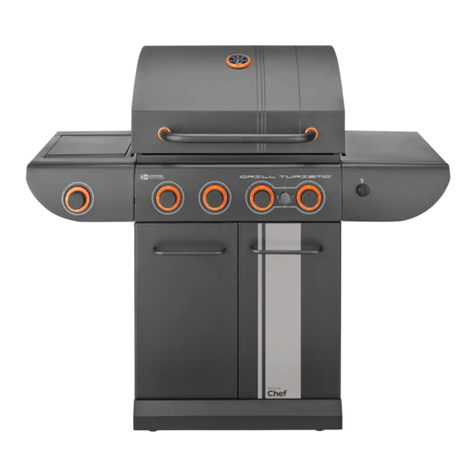
MasterChef
MasterChef GRILL TURISMO manual
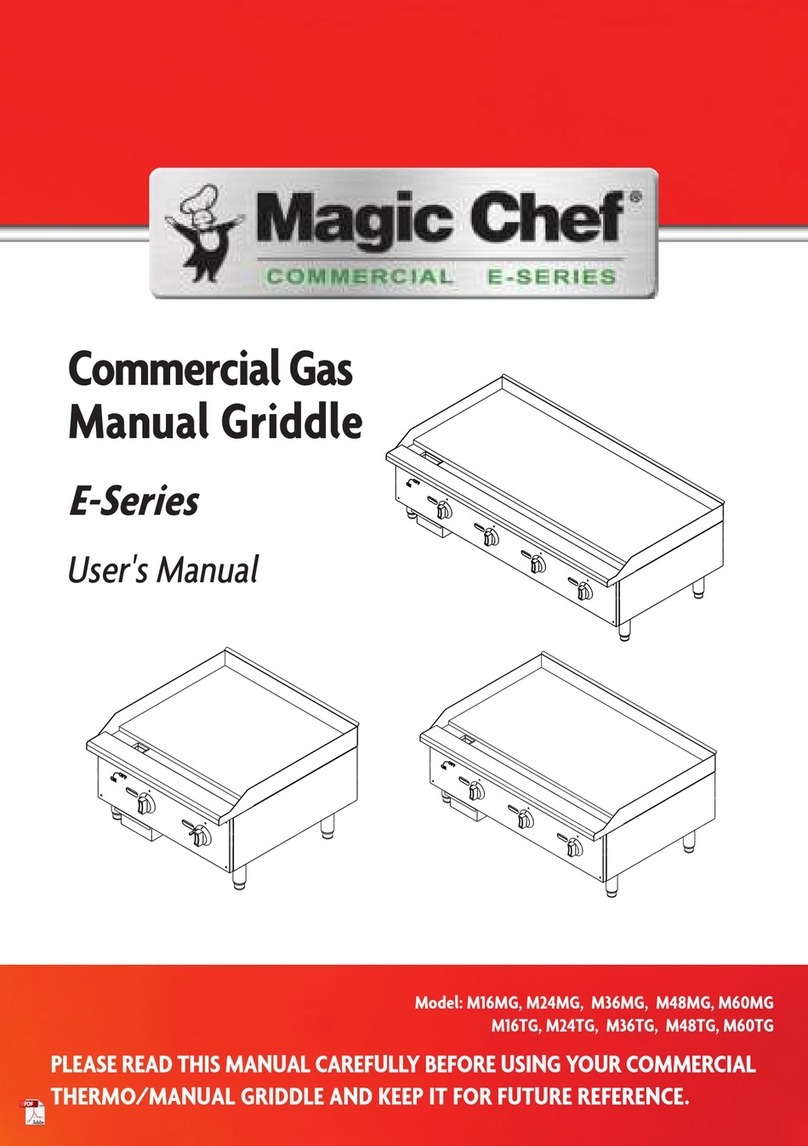
Magic Chef
Magic Chef E Series user manual

ROCKET COOKING
ROCKET COOKING RCTG-24 Installation & operation manual
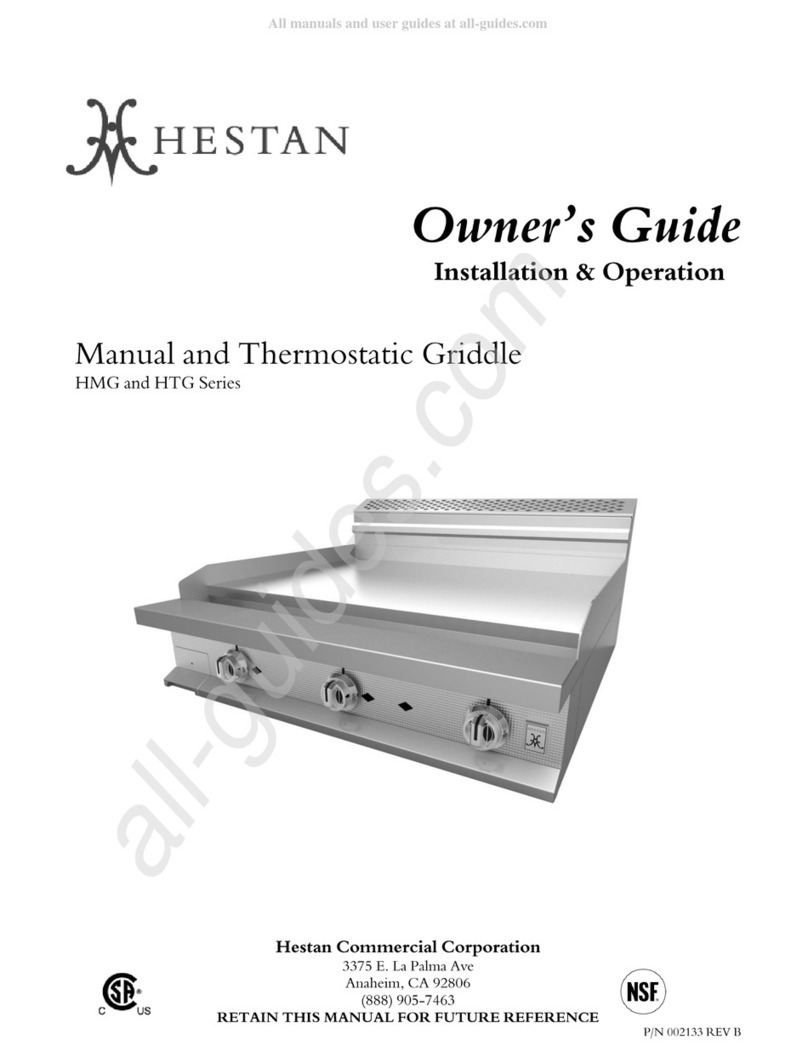
hestan
hestan HMG Series owner's guide

NISBETS ESSENTIALS
NISBETS ESSENTIALS DA397-A instruction manual
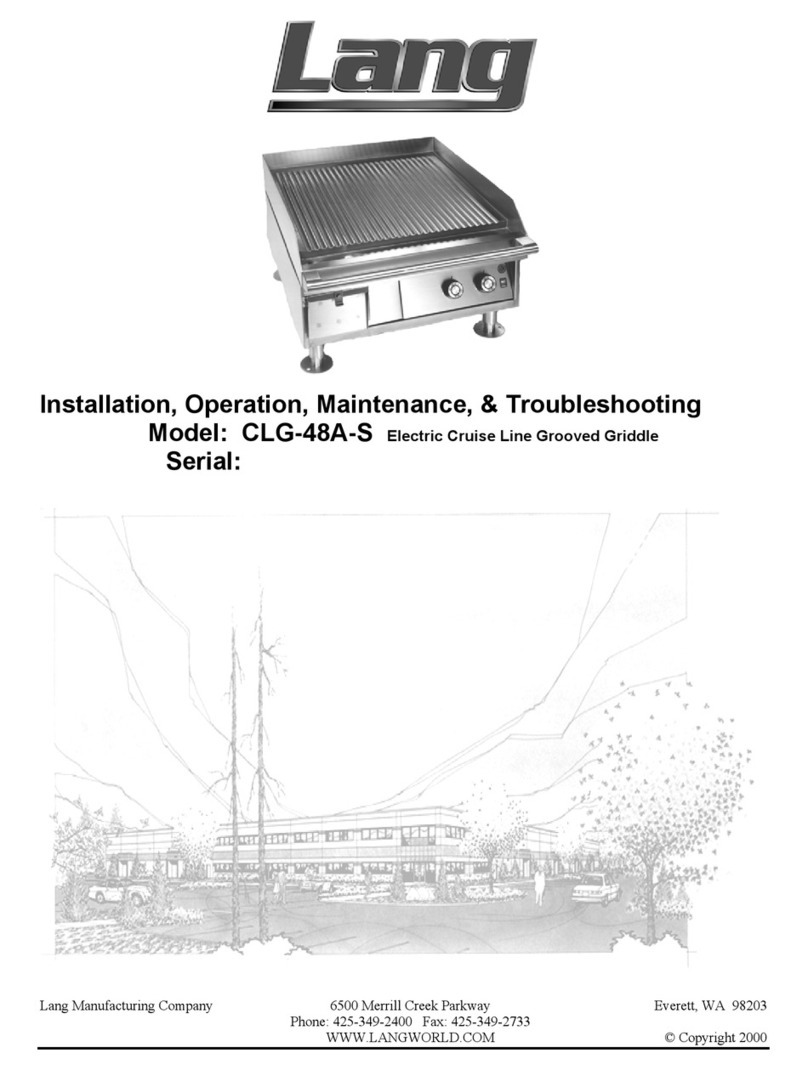
Lang
Lang CLG-48A-S Installation, operation, maintenance, & troubleshooting
